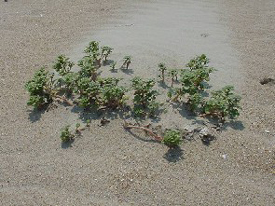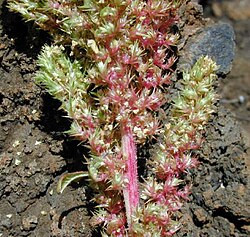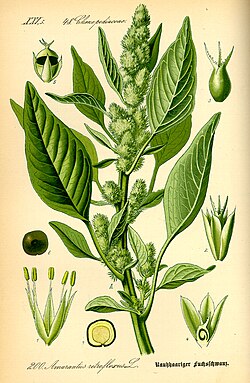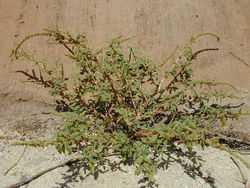Difference between revisions of "AY Honors/Edible Wild Plants/Amaranth"
| (27 intermediate revisions by the same user not shown) | |||
| Line 1: | Line 1: | ||
| − | + | {{Taxobox_begin | color=lightgreen | name= Amaranth}} | |
| + | {{Taxobox_image | image = [[Image:Amaranthus tricolor0.jpg|250px|Amaranthus tricolor]] | caption = Joseph's-coat (''Amaranthus tricolor'')}} | ||
| + | {{Taxobox_begin_placement | color = lightgreen}} | ||
| + | {{Taxobox_regnum_entry | taxon = [[Plant]]ae}} | ||
| + | {{Taxobox_divisio_entry | taxon = [[Flowering plant|Magnoliophyta]]}} | ||
| + | {{Taxobox_classis_entry | taxon = [[Magnoliopsida]]}} | ||
| + | {{Taxobox_ordo_entry | taxon = [[Caryophyllales]]}} | ||
| + | {{Taxobox familia entry | taxon = [[Amaranthaceae]]}} | ||
| + | {{Taxobox genus entry | taxon = ''Amaranthus''}} | ||
| + | {{Taxobox_end_placement}} | ||
| + | {{Taxobox_section_subdivision | color = lightgreen | plural_taxon = Species}} | ||
| + | See text | ||
| + | {{Taxobox_end}} | ||
| − | + | '''Amaranth''', or '''pigweed''', is a general term for plants of the [[genus]] ''Amaranthus'', a widely distributed genus of short-lived [[herb]]s, occurring mostly in temperate and tropical regions. Although there remains some confusion over the detailed taxonomy, there are about 60 ''Amaranthus'' species. Several of them are cultivated for their edible [[leaf vegetable|greens]] or [[seed]]s, or as [[ornamental]]s. | |
| − | + | == Food uses == | |
| − | The | + | Amaranth seed was one of the staple foodstuffs of the [[Inca]]s, and it is known as ''kiwicha'' in the [[Andes]] today. The seed was used also by the [[Aztec]]s and other Amerindian peoples in [[Mexico]] to prepare ritual drinks and foods. To this day, amaranth seeds are toasted much like [[popcorn]] and mixed with [[honey]] or [[molasses]] to make a treat called ''alegría'' in Mexican [[Spanish language|Spanish]]. |
| + | |||
| + | Amaranth was used in several Aztec ceremonies, where images of their gods were made with amaranth mixed with honey. The images were cut to be eaten by the people. This looked like the [[Christian]] [[eucharist|communion]] to the [[Catholic]] priests, so the cultivation of this seed was forbidden for centuries. Amaranth was recovered from wild varieties. | ||
| + | |||
| + | Amaranth greens are a common [[vegetable]] in [[East Asia]] and [[Southeast Asia]]. The seeds are a crop of moderate importance in the [[Himalaya]]. | ||
| + | |||
| + | Because amaranth seed is very palatable, easy to cook, and its protein particularly well suited to human nutritional needs, interest in this crop (''A. Cruentis'' and ''A. hypochondriaca'') was revived in the [[1970s]]. | ||
| + | |||
| + | == Ornamental uses == | ||
| + | |||
| + | [[Image:Amaranthus caudatus1.jpg|thumb|right|200px|Loves-lies-bleeding (Amaranthus caudatus)]] | ||
| + | |||
| + | The genus contains several well-known garden plants, such as [[Love-lies-bleeding]] (''A. caudatus''), a native of [[India]] and a vigorous, hardy annual with dark purplish [[flower]]s crowded in handsome drooping spikes. Another species ''A. hypochondriacus'', is [[Prince's Feather]], another Indian annual, with deeply-veined lance-shaped leaves, purple on the under face, and deep crimson flowers densely packed on erect spikes. | ||
== Myth, Legend and Poetry == | == Myth, Legend and Poetry == | ||
| − | ''' | + | '''Amaranth''', or Amarant (from the [[Greek language|Greek]] ''amarantos'', unwithering), a name chiefly used in poetry, and applied to Amaranth and other plants which, from not soon fading, typified immortality. Thus [[John Milton|Milton]] ([[Paradise Lost]], iii. 353) -- |
| − | |||
<blockquote> | <blockquote> | ||
| Line 26: | Line 49: | ||
It should be noted that the proper spelling of the word is amarant; the more common spelling seems to have come from a hazy notion that the final syllable is the Greek word anthos, "flower," which enters into a vast number of botanical names. | It should be noted that the proper spelling of the word is amarant; the more common spelling seems to have come from a hazy notion that the final syllable is the Greek word anthos, "flower," which enters into a vast number of botanical names. | ||
| − | In ancient [[Greece]] the amaranth (also called chrusanthemon | + | In ancient [[Greece]] the amaranth (also called chrusanthemon and elichrusos) was sacred to Ephesian [[Artemis]]. It was supposed to have special healing properties, and as a symbol of |
| − | and elichrusos) was sacred to Ephesian [[Artemis]]. | + | immortality was used to decorate images of the gods and tombs. In legend, [[Amarynthus]] (a form of Amarantus) was a hunter of Artemis and king of [[Euboea]]; in a village of Amarynthus, of which he was the eponymous hero, there was a famous temple of Artemis Amarynthia or Amarysia (Strabo x. 448; Pausan. i. 31, p. 5). |
| − | supposed to have special healing properties, and as a symbol of | ||
| − | immortality was used to decorate images of the gods and tombs. | ||
| − | In legend, [[Amarynthus]] (a form of Amarantus) was a hunter of | ||
| − | Artemis and king of [[Euboea]]; in a village of Amarynthus, of which | ||
| − | he was the eponymous hero, there was a famous temple of Artemis | ||
| − | Amarynthia or Amarysia (Strabo x. 448; Pausan. i. 31, p. 5). | ||
| − | == | + | == Species (with their common names)== |
| − | + | [[Image:Amaranthus.hybridus1web.jpg|thumb|right|250px|Green Amaranth (''A. hybridus'')]] | |
| − | + | [[Image:Seabeach Amaranth.jpg|right|thumb|275px|Seabeach amaranth (''A. pumilus''), an [[endangered species]] of amaranth]] | |
| − | + | [[Image:Illustration Amaranthus retroflexus0.jpg|thumb|right|200px|Red-root Amaranth (''A. retroflexus'') - from Thomé <br />F''lora von Deutschland, Österreich und der Schweiz'' 1885]] | |
| + | [[Image:Amaranthus.spinosus1web.jpg|thumb|right|200px|Spiny Amaranth (''Amaranthus spinosus'')]] | ||
| + | [[Image:Amaranthus.viridis1web.jpg|thumb|right|200px|Green Amaranth (''Amaranthus viridis'')]] | ||
| + | * [[Greenstripe]], ''Amaranthus acanthochiton'' | ||
| + | * [[Sharplobe Amaranth]], ''Amaranthus acutilobius'' | ||
| + | * White Pigweed, Prostrate Pigweed, Pigweed Amaranth, and White Amaranth, ''Amaranthus albus'' | ||
| + | * [[Sandhill Amaranth]], ''Amaranthus arenicola'' | ||
| + | * [[Southern Amaranth]], ''Amaranthus australis'' | ||
| + | * [[Bigelow's Amaranth]], ''Amaranthus bigelovii'' | ||
| + | * [[Mat Amaranth]], aka. Prostrate Amaranth, and Prostrate Pigweed, ''Amaranthus blitoides'' | ||
| + | * [[Purple Amaranth]], ''Amaranthus blitum'' | ||
| + | * [[Brown's Amaranth]], ''Amaranthus brownii'' | ||
| + | * [[California Amaranth]], aka. California Pigweed, ''Amaranthus californicus'' | ||
| + | * [[Tidal-marsh Amaranth]], ''Amaranthus cannabinus'' | ||
| + | * [[Loves-lies-bleeding]], aka. Pendant Amaranth, Tassel Flower, and Quilete, ''Amaranthus caudatus'' | ||
| + | * [[Chihuahuan Amaranth]], ''Amaranthus chihuahuensis'' | ||
| + | * ''Amaranthus chlorostachys'' | ||
| + | * [[Spreading Amaranth]], ''Amaranthus crassipes'' | ||
| + | * [[Crispleaf Amaranth]], ''Amaranthus crispus'' | ||
| + | * [[Purple Amaranth]], aka. Red Amaranth, Mexican Grain Amaranth, Prince’s Feather, and Caterpillar, ''Amaranthus cruentus'' | ||
| + | * [[Large-fruit Amaranth]], ''Amaranthus deflexus'' | ||
| + | * [[Spleen Amaranth]], aka. Khada Sag, ''Amaranthus dubius'' | ||
| + | * [[Fringed Amaranth]], aka. Fringed Pigweed, ''Amaranthus fimbriatus'' | ||
| + | ** Fringed Amaranth, ''Amaranthus fimbriatus denticulatus'' | ||
| + | ** [[Fringed Amaranth]], ''Amaranthus fimbriatus fimbriatus'' | ||
| + | * [[Florida Amaranth]], ''Amaranthus floridanus'' | ||
| + | * Amaranthus graecizans (not accepted) = ''Amaranthus albus'' [[Prostrate Amaranth]], Prostrate Pigweed. | ||
| + | * [[Gregg's Amaranth]], ''Amaranthus greggii'' | ||
| + | * [[Smooth Amaranth]], aka. Slim Amaranth, Spleen Amaranth, Green Amaranth, Green Pigweed, Smooth Pigweed, Red Amaranth, and Wild Beet, ''Amaranthus hybridus'' | ||
| + | ** [[Gentleman’s Cane]], ''Amaranthus hybridus erythrostachys'' | ||
| + | * [[Prince-of-Wales-feather]], aka. Princess Feather, ''Amaranthus hypochondriacus'' | ||
| + | * ''Amaranthus leucocarpus'' | ||
| + | * [[Australian Amaranth]], ''Amaranthus lineatus'' | ||
| + | * [[Purple Amaranth]], ''Amaranthus lividus'' (synonym = ''Amaranthus blitum'') | ||
| + | * [[Quinoa de Castilla]], ''Amaranthus mantegazzianus'' | ||
| + | * ''Amaranthus minimus'' | ||
| + | * [[African Amaranth]], ''Amaranthus muricatus'' | ||
| + | * Amaranthus myrianthus (synonym)(= ''Amaranthus greggii'') | ||
| + | * [[Trans-Pecos Amaranth]], ''Amaranthus obcordatus'' | ||
| + | * [[Palmer's Amaranth]], aka. Carelessweed, ''Amaranthus palmeri'' | ||
| + | * [[Reuzen Amaranth]], ''Amaranthus paniculus'' | ||
| + | * [[Tropical Amaranth]], ''Amaranthus polygonoides'' | ||
| + | * [[Green Amaranth]], aka. Powell Amaranth and Powell Pigweed, ''Amaranthus powelii'' | ||
| + | * [[Pringle's Amaranth]], ''Amaranthus pringlei'' | ||
| + | * [[Seaside Amaranth]], ''Amaranthus pumilus'' | ||
| + | * [[Ataco]], aka. Sangorache, ''Amaranthus quitensis'' | ||
| + | * [[Red-root Amaranth]], aka. Redroot Pigweed, Rough Pigweed, Green Amaranth, Wild Beet, Beetroot, Common Amaranthus, and Careless Weed; ''Amaranthus retroflexus'' | ||
| + | * [[Tall Amaranth]], aka. Common Waterhemp, ''Amaranthus rudis'' | ||
| + | * [[Bone-bract Amaranth]], ''Amaranthus scleropoides'' | ||
| + | * [[Spiny Amaranth]], aka. Prickly Amaranth and Thorny Amaranth, ''Amaranthus spinosus'' | ||
| + | * ''Amaranthus standleyanus'' | ||
| + | * ''Amaranthus tamariscinus'' (synonym = ''Amaranthus rudis'') | ||
| + | * [[Thunberg's Amaranth]], ''Amaranthus thunbergii'' | ||
| + | * [[Torrey's Amaranth]], ''Amaranthus torreyi'' | ||
| + | * [[Joseph's-coat]], ''Amaranthus tricolor'' | ||
| + | * [[Rough-fruit Amaranth]], aka. Tall Waterhemp, ''Amaranthus tuberculatus'' | ||
| + | * [[Slender Amaranth]], aka. Green Amaranth, ''Amaranthus viridis'' | ||
| + | * [[Watson's Amaranth]], ''Amaranthus watsonii'' | ||
| + | * [[Wright's Amaranth]], ''Amaranthus wrightii'' | ||
== Other things called Amaranth == | == Other things called Amaranth == | ||
| − | + | [[Globe amaranth]] belongs to an allied genus, ''[[Gomphrena]]'', and is also a native of India. It is an annual about 18 inches (450 mm) high, with solitary round heads of flowers; the heads are violet from the colour of the bracts which surround the small flowers. | |
| − | Amaranth wood or [[Purpleheart]] is from the unrelated ''Peltogyne'' ([[Fabaceae]]). It has a unique dark purplish tone to it | + | Amaranth wood or [[Purpleheart]] is from the unrelated ''[[Peltogyne]]'' ([[Fabaceae]]). It has a unique dark purplish tone to it and is used decoratively. |
[[Amaranth (dye)|Amaranth]] is a dark red to purple [[dye]] once used for [[food additive|colouring food]] but now banned by the [[FDA]]. | [[Amaranth (dye)|Amaranth]] is a dark red to purple [[dye]] once used for [[food additive|colouring food]] but now banned by the [[FDA]]. | ||
| − | + | == References == | |
| + | * Lenz, ''Botanik der alt. Greich. und Rom.'' Botany of old. (1859) | ||
| + | * J. Murr, ''Die Pflanzenwelt in der griech. Mythol.'' Plants in Greek Mythology. (1890) | ||
| + | |||
| + | == External links == | ||
| + | * [http://www.hear.org/starr/hiplants/images/thumbnails/html/amaranthus_hybridus_thumbnails.htm Amaranthus hybridus] | ||
| + | * [http://www.hear.org/starr/hiplants/images/thumbnails/html/amaranthus_spinosus_thumbnails.htm Amaranthus spinosus] | ||
| + | * [http://www.hear.org/starr/hiplants/images/600max/html/starr_010520_0109_amaranthus_viridis.htm Amaranthus viridis] | ||
| + | * [http://flora.huh.harvard.edu:8080/flora/browse.do?flora_id=1&taxon_id=101257 Flora online : Flora of North America] | ||
| + | * [http://amaranth.twoday.net/topics/Amaranthus+Info/ : Amaranthus Info] | ||
| + | |||
| + | {{Commons|Amaranthus caudatus}} | ||
| + | {{Commons|Amaranthus cruentus}} | ||
| + | {{Commons|Amaranthus hybridus}} | ||
| + | {{Commons|Amaranthus tricolor}} | ||
| + | |||
| + | {{1911}} | ||
| + | |||
| + | [[Category:Leaf vegetables]] | ||
| + | [[Category:Caryophyllales]] | ||
| + | [[cs:Laskavec]] | ||
[[de:Amaranth (Lebensmittel)]] | [[de:Amaranth (Lebensmittel)]] | ||
| + | [[es:Kiwicha]] | ||
| + | [[eo:Amaranto nutraĵa]] | ||
[[fr:Amarante]] | [[fr:Amarante]] | ||
| + | [[it:Amaranto (alimento)]] | ||
Revision as of 13:47, 1 April 2005
Template:Taxobox begin Template:Taxobox image Template:Taxobox begin placement Template:Taxobox regnum entry Template:Taxobox divisio entry Template:Taxobox classis entry Template:Taxobox ordo entry Template:Taxobox familia entry Template:Taxobox genus entry Template:Taxobox end placement Template:Taxobox section subdivision See text Template:Taxobox end
Amaranth, or pigweed, is a general term for plants of the genus Amaranthus, a widely distributed genus of short-lived herbs, occurring mostly in temperate and tropical regions. Although there remains some confusion over the detailed taxonomy, there are about 60 Amaranthus species. Several of them are cultivated for their edible greens or seeds, or as ornamentals.
Food uses
Amaranth seed was one of the staple foodstuffs of the Incas, and it is known as kiwicha in the Andes today. The seed was used also by the Aztecs and other Amerindian peoples in Mexico to prepare ritual drinks and foods. To this day, amaranth seeds are toasted much like popcorn and mixed with honey or molasses to make a treat called alegría in Mexican Spanish.
Amaranth was used in several Aztec ceremonies, where images of their gods were made with amaranth mixed with honey. The images were cut to be eaten by the people. This looked like the Christian communion to the Catholic priests, so the cultivation of this seed was forbidden for centuries. Amaranth was recovered from wild varieties.
Amaranth greens are a common vegetable in East Asia and Southeast Asia. The seeds are a crop of moderate importance in the Himalaya.
Because amaranth seed is very palatable, easy to cook, and its protein particularly well suited to human nutritional needs, interest in this crop (A. Cruentis and A. hypochondriaca) was revived in the 1970s.
Ornamental uses
The genus contains several well-known garden plants, such as Love-lies-bleeding (A. caudatus), a native of India and a vigorous, hardy annual with dark purplish flowers crowded in handsome drooping spikes. Another species A. hypochondriacus, is Prince's Feather, another Indian annual, with deeply-veined lance-shaped leaves, purple on the under face, and deep crimson flowers densely packed on erect spikes.
Myth, Legend and Poetry
Amaranth, or Amarant (from the Greek amarantos, unwithering), a name chiefly used in poetry, and applied to Amaranth and other plants which, from not soon fading, typified immortality. Thus Milton (Paradise Lost, iii. 353) --
- "Immortal amarant, a flower which once
- In paradise, fast by the tree of life,
- Began to bloom; but soon for man's offence
- To heaven removed, where first it grew, there grows,
- And flowers aloft, shading the fount of life,
- And where the river of bliss through midst of heaven
- Rolls o'er elysian flowers her amber stream:
- With these that never fade the spirits elect
- Bind their resplendent locks."
It should be noted that the proper spelling of the word is amarant; the more common spelling seems to have come from a hazy notion that the final syllable is the Greek word anthos, "flower," which enters into a vast number of botanical names.
In ancient Greece the amaranth (also called chrusanthemon and elichrusos) was sacred to Ephesian Artemis. It was supposed to have special healing properties, and as a symbol of immortality was used to decorate images of the gods and tombs. In legend, Amarynthus (a form of Amarantus) was a hunter of Artemis and king of Euboea; in a village of Amarynthus, of which he was the eponymous hero, there was a famous temple of Artemis Amarynthia or Amarysia (Strabo x. 448; Pausan. i. 31, p. 5).
Species (with their common names)

- Greenstripe, Amaranthus acanthochiton
- Sharplobe Amaranth, Amaranthus acutilobius
- White Pigweed, Prostrate Pigweed, Pigweed Amaranth, and White Amaranth, Amaranthus albus
- Sandhill Amaranth, Amaranthus arenicola
- Southern Amaranth, Amaranthus australis
- Bigelow's Amaranth, Amaranthus bigelovii
- Mat Amaranth, aka. Prostrate Amaranth, and Prostrate Pigweed, Amaranthus blitoides
- Purple Amaranth, Amaranthus blitum
- Brown's Amaranth, Amaranthus brownii
- California Amaranth, aka. California Pigweed, Amaranthus californicus
- Tidal-marsh Amaranth, Amaranthus cannabinus
- Loves-lies-bleeding, aka. Pendant Amaranth, Tassel Flower, and Quilete, Amaranthus caudatus
- Chihuahuan Amaranth, Amaranthus chihuahuensis
- Amaranthus chlorostachys
- Spreading Amaranth, Amaranthus crassipes
- Crispleaf Amaranth, Amaranthus crispus
- Purple Amaranth, aka. Red Amaranth, Mexican Grain Amaranth, Prince’s Feather, and Caterpillar, Amaranthus cruentus
- Large-fruit Amaranth, Amaranthus deflexus
- Spleen Amaranth, aka. Khada Sag, Amaranthus dubius
- Fringed Amaranth, aka. Fringed Pigweed, Amaranthus fimbriatus
- Fringed Amaranth, Amaranthus fimbriatus denticulatus
- Fringed Amaranth, Amaranthus fimbriatus fimbriatus
- Florida Amaranth, Amaranthus floridanus
- Amaranthus graecizans (not accepted) = Amaranthus albus Prostrate Amaranth, Prostrate Pigweed.
- Gregg's Amaranth, Amaranthus greggii
- Smooth Amaranth, aka. Slim Amaranth, Spleen Amaranth, Green Amaranth, Green Pigweed, Smooth Pigweed, Red Amaranth, and Wild Beet, Amaranthus hybridus
- Gentleman’s Cane, Amaranthus hybridus erythrostachys
- Prince-of-Wales-feather, aka. Princess Feather, Amaranthus hypochondriacus
- Amaranthus leucocarpus
- Australian Amaranth, Amaranthus lineatus
- Purple Amaranth, Amaranthus lividus (synonym = Amaranthus blitum)
- Quinoa de Castilla, Amaranthus mantegazzianus
- Amaranthus minimus
- African Amaranth, Amaranthus muricatus
- Amaranthus myrianthus (synonym)(= Amaranthus greggii)
- Trans-Pecos Amaranth, Amaranthus obcordatus
- Palmer's Amaranth, aka. Carelessweed, Amaranthus palmeri
- Reuzen Amaranth, Amaranthus paniculus
- Tropical Amaranth, Amaranthus polygonoides
- Green Amaranth, aka. Powell Amaranth and Powell Pigweed, Amaranthus powelii
- Pringle's Amaranth, Amaranthus pringlei
- Seaside Amaranth, Amaranthus pumilus
- Ataco, aka. Sangorache, Amaranthus quitensis
- Red-root Amaranth, aka. Redroot Pigweed, Rough Pigweed, Green Amaranth, Wild Beet, Beetroot, Common Amaranthus, and Careless Weed; Amaranthus retroflexus
- Tall Amaranth, aka. Common Waterhemp, Amaranthus rudis
- Bone-bract Amaranth, Amaranthus scleropoides
- Spiny Amaranth, aka. Prickly Amaranth and Thorny Amaranth, Amaranthus spinosus
- Amaranthus standleyanus
- Amaranthus tamariscinus (synonym = Amaranthus rudis)
- Thunberg's Amaranth, Amaranthus thunbergii
- Torrey's Amaranth, Amaranthus torreyi
- Joseph's-coat, Amaranthus tricolor
- Rough-fruit Amaranth, aka. Tall Waterhemp, Amaranthus tuberculatus
- Slender Amaranth, aka. Green Amaranth, Amaranthus viridis
- Watson's Amaranth, Amaranthus watsonii
- Wright's Amaranth, Amaranthus wrightii
Other things called Amaranth
Globe amaranth belongs to an allied genus, Gomphrena, and is also a native of India. It is an annual about 18 inches (450 mm) high, with solitary round heads of flowers; the heads are violet from the colour of the bracts which surround the small flowers.
Amaranth wood or Purpleheart is from the unrelated Peltogyne (Fabaceae). It has a unique dark purplish tone to it and is used decoratively.
Amaranth is a dark red to purple dye once used for colouring food but now banned by the FDA.
References
- Lenz, Botanik der alt. Greich. und Rom. Botany of old. (1859)
- J. Murr, Die Pflanzenwelt in der griech. Mythol. Plants in Greek Mythology. (1890)
External links
- Amaranthus hybridus
- Amaranthus spinosus
- Amaranthus viridis
- Flora online : Flora of North America
- : Amaranthus Info
Template:Commons Template:Commons Template:Commons Template:Commons
cs:Laskavec de:Amaranth (Lebensmittel) es:Kiwicha eo:Amaranto nutraĵa fr:Amarante it:Amaranto (alimento)





